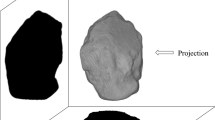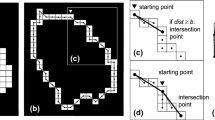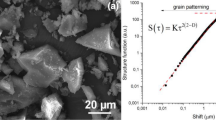Abstract
Particle morphology at different length scales is important in understanding the mechanical behaviour of granular materials. In this sense, it is crucial to accurately describe and measure the size and shape of the grains using suitable definitions of morphological descriptors. Most of the research up until this point has analyzed particle shape in a two-dimensional framework, and sieving has typically been used to determine size. This paper describes the use of x-ray micro-computed tomography (µCT) which enables the visualization and quantification of three-dimensional particle morphology. Spherical harmonic analysis was used to reconstruct the three-dimensional (3D) realistic surface of the granular particles. 3D morphological descriptors were then introduced and computed to obtain the overall form, local features, and surface textures of the particle morphology based on the spherical harmonic reconstructed surface. To describe the fractal nature of the surfaces of natural sand particle morphology, the 3D fractal dimension was quantified using spherical harmonic-based fractal analysis. Complete volume-based distributions of particle morphological descriptors were presented and compared for four different sand samples with different grain size and shape characteristics. According to the statistical analysis, there is a clear correlation between the shape parameters at various characteristic scales, indicating that they are not independent measures. The correlation between any two parameters was observed to rely on the distance between the characteristic scales of the morphological parameters.
Graphic abstract





















Similar content being viewed by others
Data availability
The datasets generated during and/or analyzed during the current study are available from the corresponding author on reasonable request.
References
Jo, S.A., Kim, E.K., Cho, G.C., Lee, S.W.: Particle shape and crushing effects on direct shear behavior using dem. Soils Found. 51, 701–712 (2011). https://doi.org/10.3208/sandf.51.701
Tian, J., Liu, E., He, C.: Shear band analysis of granular materials considering effects of particle shape. Acta Mech. 231, 4445–4461 (2020). https://doi.org/10.1007/s00707-020-02771-y
Lashkari, A., Jamali, V.: Global and local sand–geosynthetic interface behaviour. Geotechnique 71, 346–367 (2021). https://doi.org/10.1680/jgeot.19.P.109
Cundall, P.A., Strack, O.D.L.: A discrete numerical model for granular assemblies. Geotechnique 29, 47–65 (1979)
Höhner, D., Wirtz, S., Scherer, V.: A study on the influence of particle shape on the mechanical interactions of granular media in a hopper using the discrete element method. Powder Technol. 278, 286–305 (2015). https://doi.org/10.1016/j.powtec.2015.02.046
Ai, J., Chen, J.F., Rotter, J.M., Ooi, J.Y.: Assessment of rolling resistance models in discrete element simulations. Powder Technol. 206, 269–282 (2011). https://doi.org/10.1016/j.powtec.2010.09.030
Zhao, S., Zhou, X., Liu, W.: Discrete element simulations of direct shear tests with particle angularity effect. Granul. Matter 17, 793–806 (2015). https://doi.org/10.1007/s10035-015-0593-x
Danesh, A., Mirghasemi, A.A., Palassi, M.: Evaluation of particle shape on direct shear mechanical behavior of ballast assembly using discrete element method (DEM). Transp. Geotech. 23, 100357 (2020). https://doi.org/10.1016/j.trgeo.2020.100357
Zhou, Y., Wang, H., Zhou, B., Li, J.: DEM-aided direct shear testing of granular sands incorporating realistic particle shape. Granul. Matter 20, 20–55 (2018). https://doi.org/10.1007/s10035-018-0828-8
Alshibli, K.A., Alsaleh, M.I.: Characterizing surface roughness and shape of sands using digital microscopy. J. Comput. Civ. Eng. 18, 36–45 (2004). https://doi.org/10.1061/(ASCE)0887-3801(2004)18:1(36)
Altuhafi, F., O’Sullivan, C., Cavarretta, I.: Analysis of an image-based method to quantify the size and shape of sand particles. J. Geotech. Geoenvironmental Eng. 139, 1290–1307 (2013). https://doi.org/10.1061/(ASCE)GT.1943-5606.0000855
Mora, C.F., Kwan, A.K.H.: Sphericity, shape factor, and convexity measurement of coarse aggregate for concrete using digital image processing. Cem. Concr. Res. 30, 351–358 (2000). https://doi.org/10.1016/S0008-8846(99)00259-8
Sukumaran, B., Ashmawy, A.K.: Quantitative characterisation of the geometry of discrete particles. Géotechnique. 51, 619–627 (2001). https://doi.org/10.1680/geot.51.7.619.51393
Vangla, P., Roy, N., Latha, G.M.: Image based shape characterization of granular materials and its effect on kinematics of particle motion. Granul. Matter 20, 1–19 (2018). https://doi.org/10.1007/s10035-017-0776-8
Fonseca, J., O’Sullivan, C., Coop, M.R., Lee, P.D.: Non-invasive characterization of particle morphology of natural sands. Soils Found. 52, 712–722 (2012). https://doi.org/10.1016/j.sandf.2012.07.011
Zheng, W., Hu, X., Tannant, D.D., Zhang, K., Xu, C.: Characterization of two- and three-dimensional morphological properties of fragmented sand grains. Eng. Geol. 263, 105358 (2019). https://doi.org/10.1016/j.enggeo.2019.105358
Alshibli, K.A., Druckrey, A.M., Al-Raoush, R.I., Weiskittel, T., Lavrik, N.V.: Quantifying morphology of sands using 3D imaging. J. Mater. Civ. Eng. 27, 1–10 (2015). https://doi.org/10.1061/(asce)mt.1943-5533.0001246
Kong, D., Fonseca, J.: Quantification of the morphology of shelly carbonate sands using 3D images. Geotechnique 68, 249–261 (2018). https://doi.org/10.1680/jgeot.16.P.278
Zhou, B., Wang, J.: Generation of a realistic 3D sand assembly using X-ray micro-computed tomography and spherical harmonic-based principal component analysis. Int. J. Numer. Anal. Methods Geomech. 41, 93–109 (2017). https://doi.org/10.1002/nag.2548
Zhao, B., Wang, J.: 3D quantitative shape analysis on form, roundness, and compactness with μCT. Powder Technol. 291, 262–275 (2016). https://doi.org/10.1016/j.powtec.2015.12.029
Zhou, B., Wang, J., Wang, H.: Three-dimensional sphericity, roundness and fractal dimension of sand particles. Geotechnique 68, 18–30 (2018). https://doi.org/10.1680/jgeot.16.P.207
Su, D., Yan, W.M.: 3D characterization of general-shape sand particles using microfocus X-ray computed tomography and spherical harmonic functions, and particle regeneration using multivariate random vector. Powder Technol. 323, 8–23 (2018). https://doi.org/10.1016/J.POWTEC.2017.09.030
Yang, H.W., Lourenço, S.D.N., Baudet, B.A.: 3D fractal analysis of multi-scale morphology of sand particles with μCT and interferometer. Geotechnique 72, 20–33 (2022). https://doi.org/10.1680/jgeot.19.P.120
Alam, M.F., Haque, A.: A new cluster analysis-marker-controlled watershed method for separating particles of granular soils. Materials (Basel). 10, (2017). https://doi.org/10.3390/ma10101195
Shi, Y., Yan, W.M.: Segmentation of irregular porous particles of various sizes from X-ray microfocus computer tomography images using a novel adaptive watershed approach. Geotech. Lett. 5, 299–305 (2015). https://doi.org/10.1680/jgele.15.00100
Sun, Q., Zheng, J., Li, C.: Improved watershed analysis for segmenting contacting particles of coarse granular soils in volumetric images. Powder Technol. 356, 295–303 (2019). https://doi.org/10.1016/j.powtec.2019.08.028
Zheng, J., Hryciw, R.D.: Segmentation of contacting soil particles in images by modified watershed analysis. Comput. Geotech. 73, 142–152 (2016). https://doi.org/10.1016/j.compgeo.2015.11.025
Field, D.A.: Laplacian smoothing and Delaunay triangulations. Commun. Appl. Numer. Methods. 4, 709–712 (1988). https://doi.org/10.1002/cnm.1630040603
Kobbelt, L.P., Botsch, M., Schwanecke, U., Seidel, H.P.: Feature sensitive surface extraction from volume data. In: Proceedings of the 28th Annual Conference on Computer Graphics and Interactive Techniques. pp. 57–66. , Los Angeles, CA, USA (2001)
Mollon, G., Zhao, J.: Generating realistic 3D sand particles using Fourier descriptors. Granul. Matter 15, 95–108 (2013). https://doi.org/10.1007/s10035-012-0380-x
Mollon, G., Zhao, J.: 3D generation of realistic granular samples based on random fields theory and Fourier shape descriptors. Comput. Methods Appl. Mech. Eng. 279, 46–65 (2014). https://doi.org/10.1016/j.cma.2014.06.022
Mandelbrot, B.B., Passoja, D.E., Paullay, A.J.: Fractal character of fracture surfaces of metals. Nature 308, 721–722 (1984). https://doi.org/10.1038/308721a0
Kaye, B.H.: A random walk through fractal dimensions. John Wiley & Sons, Ltd (1994)
Clarke, K.C.: Computation of the fractal dimension of topographic surfaces using the triangualr prism surface area method. Comput. Geosci. 12, 713–722 (1986)
Yang, H., Baudet, B.A., Yao, T.: Characterization of the surface roughness of sand particles using an advanced fractal approach. In: Proceedings of the Royal Society A: Mathematical, Physical and Engineering Sciences. p. 20160524 (2016)
Charkaluk, E., Bigerelle, M., Iost, A.: Fractals and fracture. Eng. Fract. Mech. 61, 119–139 (1998). https://doi.org/10.1016/S0013-7944(98)00035-6
Wadell, H.: Volume, shape, and roundness of quartz particles. J. Geol. 43, 250–280 (1935)
Cho, G.-C., Dodds, J., Santamarina, J.C.: Particle shape effects on packing density, stiffness, and strength: natural and crushed sands. J. Geotech. Geoenvironmental Eng. 132, 591–602 (2006). https://doi.org/10.1061/(asce)1090-0241(2006)132:5(591)
Barrett, P.J.: The shape of rock particles, a critical review. Sedimentology 27, 291–303 (1980)
Zheng, W., Hu, X., Tannant, D.D.: Shape characterization of fragmented sand grains via x-ray computed tomography imaging. Int. J. Geomech. 20, 1–14 (2020). https://doi.org/10.1061/(asce)gm.1943-5622.0001599
Otsu, N.: A threshold selection method from gray-level histograms. IEEE Trans. Syst. Man Cybern. 9, 62–66 (1979)
Zhou, B., Wang, J.: Random generation of natural sand assembly using micro x-ray tomography and spherical harmonics. Geotech. Lett. 5, 6–11 (2015). https://doi.org/10.1680/geolett.14.00082
Zhou, B., Wang, J., Zhao, B.: Micromorphology characterization and reconstruction of sand particles using micro x-ray tomography and spherical harmonics. Eng. Geol. 184, 126–137 (2015). https://doi.org/10.1016/j.enggeo.2014.11.009
Sun, Q., Zheng, J.: Realistic soil particle generation based on limited morphological information by probability-based spherical harmonics. Comput. Part. Mech. 8, 215–235 (2021). https://doi.org/10.1007/s40571-020-00325-6
Masad, E., Saadeh, S., Al-Rousan, T., Garboczi, E., Little, D.: Computations of particle surface characteristics using optical and x-ray CT images. Comput. Mater. Sci. 34, 406–424 (2005). https://doi.org/10.1016/j.commatsci.2005.01.010
Capozza, R., Hanley, K.J.: A hierarchical, spherical harmonic-based approach to simulate abradable, irregularly shaped particles in DEM. Powder Technol. 378, 528–537 (2021). https://doi.org/10.1016/j.powtec.2020.10.015
Deiros Quintanilla, I., Combe, G., Emeriault, F., Voivret, C., Ferellec, J.F.: X-ray CT analysis of the evolution of ballast grain morphology along a Micro-Deval test: key role of the asperity scale. Granul. Matter 21, 21–30 (2019). https://doi.org/10.1007/s10035-019-0881-y
Fu, R., Hu, X., Zhou, B.: Discrete element modeling of crushable sands considering realistic particle shape effect. Comput. Geotech. 91, 179–191 (2017). https://doi.org/10.1016/j.compgeo.2017.07.016
Zheng, W., Hu, X., Tannant, D.D., Zhou, B.: Quantifying the influence of grain morphology on sand hydraulic conductivity: a detailed pore-scale study. Comput. Geotech. 135, 104147 (2021). https://doi.org/10.1016/j.compgeo.2021.104147
Wei, D., Wang, J., Nie, J., Zhou, B.: Generation of realistic sand particles with fractal nature using an improved spherical harmonic analysis. Comput. Geotech. 104, 1–12 (2018). https://doi.org/10.1016/j.compgeo.2018.08.002
Zhou, B., Wei, D., Ku, Q., Wang, J., Zhang, A.: Study on the effect of particle morphology on single particle breakage using a combined finite-discrete element method. Comput. Geotech. 122, 103532 (2020). https://doi.org/10.1016/j.compgeo.2020.103532
Clayton, C.R.I., Abbireddy, C.O.R., Schiebel, R.: A method of estimating the form of coarse particulates. Geotechnique 59, 493–501 (2009). https://doi.org/10.1680/geot.2007.00195
Angelidakis, V., Nadimi, S., Utili, S.: Elongation, flatness and compactness indices to characterise particle form. Powder Technol. 396, 689–695 (2022). https://doi.org/10.1016/j.powtec.2021.11.027
Zingg, T.: Beitrag zur Schotteranalyse. Schweiz. Miner. Petrogr. Mitt. 15, 52–56 (1935)
Blott, S.J., Pye, K.: Particle shape: a review and new methods of characterization and classification. Sedimontology. 55, 31–63 (2008)
Buscarnera, G., Einav, I.: The mechanics of brittle granular materials with coevolving grain size and shape. In: Proceedings of the Royal Society A: Mathematical, Physical and Engineering Sciences (2021)
Garboczi, E.J.: Three-dimensional mathematical analysis of particle shape using x-ray tomography and spherical harmonics: application to aggregates used in concrete. Cem. Concr. Res. 32, 1621–1638 (2002). https://doi.org/10.1016/S0008-8846(02)00836-0
Do Carmo, M.P.: Differential geometry of curves and surfaces. Prentice-Hall, Englewood Cliffs, New Jersey, USA (1976)
Russ, J.: Fractal surfaces. Plenum Press, New York and London, Rayleigh, North Carolina (1994)
Chan, K.L.: Quantitative characterization of electron micrograph image using fractal feature. IEEE Trans. Biomed. Eng. 42, 1033–1037 (1995)
Quevedo, R., Mendoza, F., Aguilera, J.M., Chanona, J., Gutiérrez-López, G.: Determination of senescent spotting in banana (Musa cavendish) using fractal texture Fourier image. J. Food Eng. 84, 509–515 (2008). https://doi.org/10.1016/J.JFOODENG.2007.06.013
Kazhdan, M., Funkhouser, T., Rusinkiewicz, S.: Rotation invariant spherical harmonic representation of 3D shape descriptors. Eurographics Symp. Geom. Process. 43, 156–164 (2003)
Matsushima, T., Chang, C.S.: Quantitative evaluation of the effect of irregularly shaped particles in sheared granular assemblies. Granul. Matter 13, 269–276 (2011). https://doi.org/10.1007/s10035-011-0263-6
Nie, Z., Liang, Z., Wang, X.: A three-dimensional particle roundness evaluation method. Granul. Matter 20, 1–11 (2018). https://doi.org/10.1007/s10035-018-0802-5
Majumdar, A., Bhushan, B.: Role of fractal geometry in roughness characterization and contact mechanics of surfaces. J. Tribol. 112, 205–216 (1990)
Bagi, K., Orosz, Á.: A new variable for characterising irregular element geometries in experiments and DEM simulations. In: Proceedings–European Council for Modelling and Simulation, ECMS. pp. 256–260 (2020)
Potticary M., Zervos A., H.J.: An investigation into the effect of particle platyness on the strength of granular materials using the discrete element method. In: Proceedings of the 4th International Conference on Particle-Based Methods—Fundamentals and Applications, CIMNE 2015. pp. 767–778 (2015)
Acknowledgements
The computational facilities used for this study were procured through the DRIP funding of the Department of Civil Engineering of the Indian Institute of Science. Authors are grateful to the Ministry of Water Resources, India for this financial support.
Author information
Authors and Affiliations
Corresponding author
Ethics declarations
Conflict of interest
The authors affirm that they have no known financial or interpersonal conflicts that would have seemed to affect their work.
Additional information
Publisher's Note
Springer Nature remains neutral with regard to jurisdictional claims in published maps and institutional affiliations.
Rights and permissions
Springer Nature or its licensor (e.g. a society or other partner) holds exclusive rights to this article under a publishing agreement with the author(s) or other rightsholder(s); author self-archiving of the accepted manuscript version of this article is solely governed by the terms of such publishing agreement and applicable law.
About this article
Cite this article
Khan, R., Latha, G.M. Statistical interdependence of multi-scale 3D morphological descriptors of sand grains. Granular Matter 26, 19 (2024). https://doi.org/10.1007/s10035-023-01390-3
Received:
Accepted:
Published:
DOI: https://doi.org/10.1007/s10035-023-01390-3




